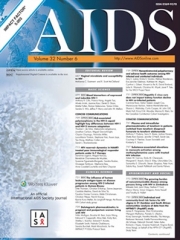Posted on March 27, 2015
Source: AIDS

Solomon, Sunil S.; Mehta, Shruti H.; Srikrishnan, Aylur K.; Vasudevan, Canjeevaram K.; Mcfall, Allison M.; Balakrishnan, Pachamuthu; Anand, Santhanam; Nandagopal, Panneerselvam; Ogburn, Elizabeth L.; Laeyendecker, Oliver; Lucas, Gregory M.; Solomon, Suniti; Celentano, David D.
Objective: To characterize prevalence, incidence, and associated correlates of HIV infection among MSM in 12 cities across India.
Design: Cross-sectional sample using respondent-driven sampling from September 2012 to June 2013.
Methods: A total 12 022 MSM (∼1000/city) were recruited. Participants had to be at least 18 years, self-identify as male, and report oral/anal intercourse with a man in the prior year. HIV infection was diagnosed using three rapid tests. Cross-sectional HIV incidence was estimated using a multiassay algorithm. All estimates incorporate respondent-driven sampling-II weights.
Results: Median age was 25 years, 45% self-identified as ‘panthi’ (predominantly penetrative anal intercourse) and 30.6% reported being married to a woman. Weighted HIV prevalence was 7.0% (range: 1.7–13.1%). In multivariate analysis, significantly higher odds of HIV infection was observed among those who were older, had lower educational attainment, were practicing purely receptive anal sex or both receptive and penetrative sex, and those who were herpes simplex virus-2 positive. Of 1147 MSM who tested HIV positive, 53 were identified as recent HIV infections (annualized incidence = 0.87%; range = 0–2.2%). In multivariate analysis, injecting drugs in the prior 6 months, syphilis, and higher number of male partners and fewer female partners were significantly associated with recent HIV infection.
Conclusion: We observed a high burden of HIV among MSM in India with tremendous diversity in prevalence, incidence, and risk behaviors. In particular, we observed high incidence in areas with relatively low prevalence suggesting emerging epidemics in areas not previously recognized to have high HIV burden.